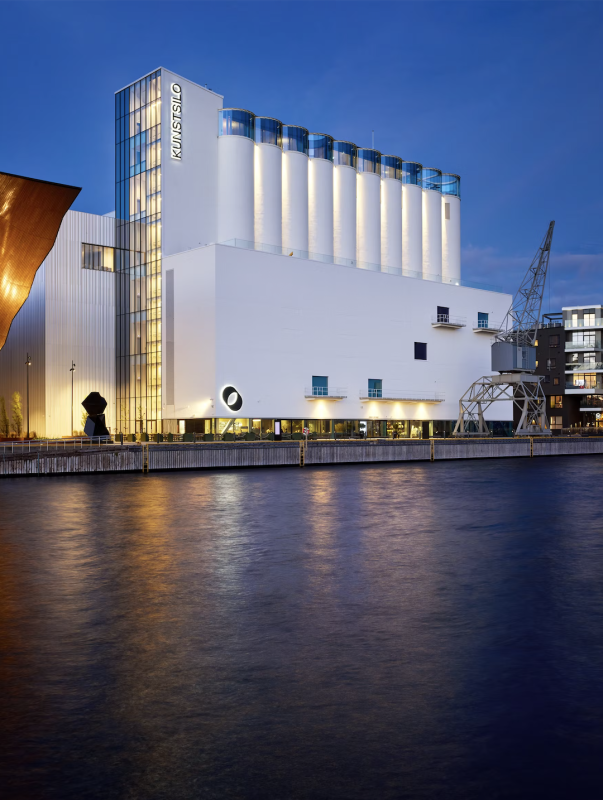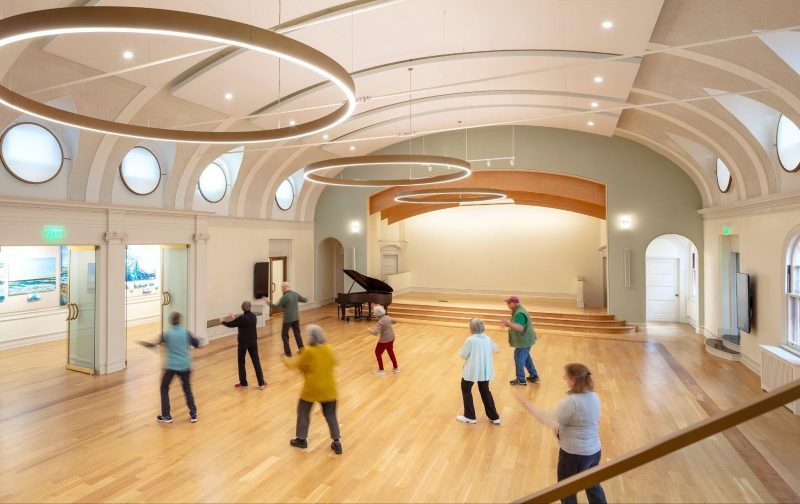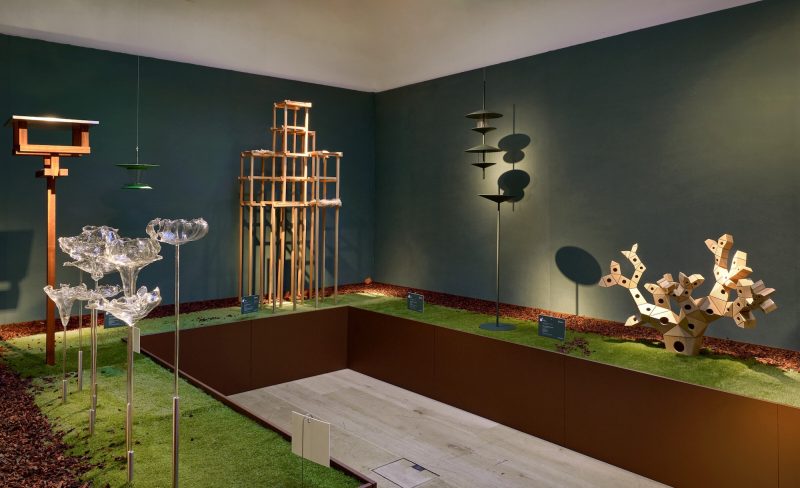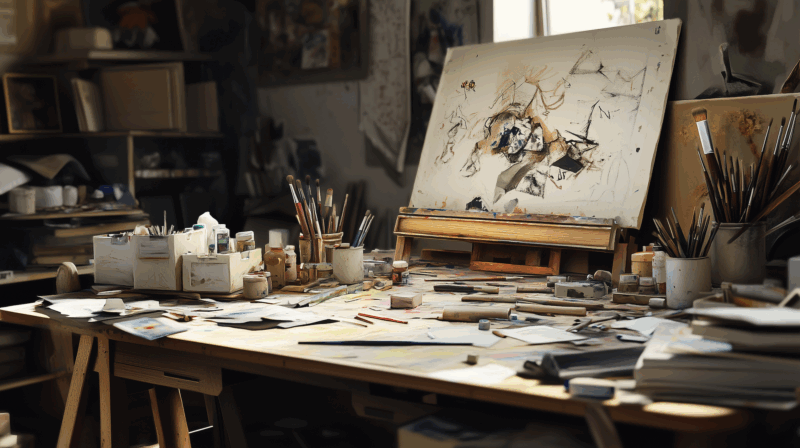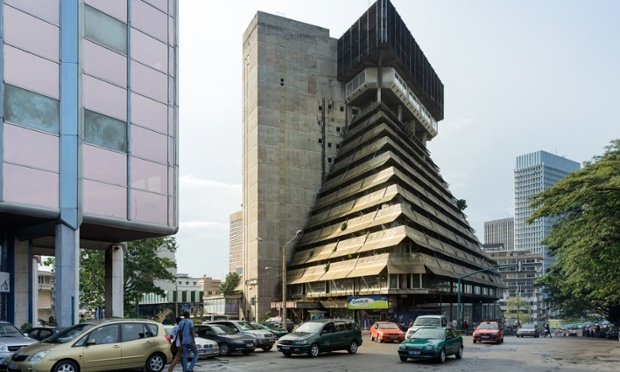
La Pyramide, Abidjan, Ivory Coast. Photograph: Iwan Baan
Afield of triangular roofs pokes up above the horizon on the outskirts of Dakar, like a forest of wigwams that have been baked to stone under the scorching sub-Saharan sun. They sit on a triangular concrete plinth, from which bigger triangular pavilions protrude, accessed by flights of triangular steps from the dusty streets, along which triangular gutters jut out. It could be Toblerone Town, a city-sized hymn to the three-sided prism.
This mysterious complex, which looks like what might have happened if the Mayans had discovered reinforced concrete, is the Foire Internationale de Dakar, or FIDAK for short. It is a sprawling exhibition centre built in the capital of Senegal in 1975 to host the country’s biennial international trade fair – and trumpet the new nationstate’s presence on the global stage. Designed by little-known French architects Jean-François Lamoureux and Jean-Louis Marin, it is a project of obsessive and extraordinary detail. There are facades decorated with coloured pebbles and tiled mosaics, psychedelic sand art murals that evoke the rocky African coastline and its azure seas. Yet outside Senegal, this building is almost entirely unknown.
It is just one of the astounding projects documented by Swiss architect Manuel Herz, who has spent the last few years researching the architecture of African independence with his team at ETH University in Zurich. A period of bold structures and strident new forms, it is strangely absent from the recorded history of modern architecture. “There was an intense flowering of experimental and futuristic architecture in the 1960s and 70s, which the young African countries used to express their national identities,” says Herz, who has curated an exhibition of more than 80 buildings from sub-Saharan Africa, showing at the Vitra Design Museum in Weil am Rhein, Germany, until May. “But we simply don’t know about it. When people think of Africa, they think of poverty, misery and violence, while architects fetishise informality and focus on slum-upgrading. But we wanted to show this incredible cultural wealth that also exists.”
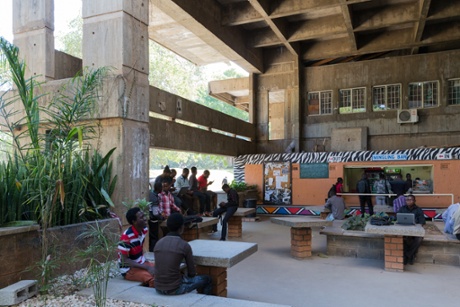
The buildings, a number of which have been beautifully shot by Dutch photographer Iwan Baan, portray a period of extreme confidence and political ambition. They are mostly the products of big, state-sponsored initiatives, from heroic parliament buildings and imposing central banks to daring universities and vast stadiums, many the pet projects of Africa’s “big man” leaders, built for propaganda purposes as much as anything else.
The Kenyatta International Conference Centre, whose pink cylindrical shaft towers above Nairobi, was initiated by the country’s first president, Jomo Kenyatta, as a lavish new HQ for his ruling Kanu party. At 32 storeys, it was by far the tallest structure in east Africa until the 1990s, a big column for Kenya’s big-man chieftain. Yet its great size can be credited to an accident of international intervention. In the midst of its design, the World Bank decided it would host its 1973 annual meeting in Nairobi, and the building was chosen as the venue, forcing a growth spurt. The tower almost tripled in height, while a magnificent auditorium shaped like a closed lily-bud was also added, and mirrored by an open flower form at the top of the tower containing a revolving restaurant.
It was the work of Norwegian architect Karl Henrik Nøstvik, who had been sent to Kenya as part of the Norwegian aid package and proved attractive to Kenyatta, being from a country without a murky colonial past. Scandinavian architects loom large in the period for this reason, bringing their mastery of expressive concrete and sculpting with light – but mercifully freed, in the tropics, from the pesky northern European necessities of windows and insulation. In Africa, the inside-outside dream could finally be realised – and so European modernists let rip.
With its cascading concrete terraces and intersecting outdoor walkways, the University of Zambia in Lusaka, designed in 1965, is a powerful demonstration of this free-flowing landscape ideal. Arranged along an axial spine, the faculty buildings have exposed staircases and galleries on multiple levels, with small niches, kiosks and seating areas built in, creating streetlike social bustle.
Although the campus was revolutionary, given that its flexible plan allowed for future growth, it would fall foul of international political flux. It was built by Israeli contractors, like many of the major projects of this era, as Israel was a natural postcolonial partner for the fledging states, and in need of new allies at the UN council. But the honeymoon period would come to a sharp end in the early 1970s, when the Yom Kippur war and the first oil crisis made most African countries switch allegiance to the Arab nations and the Palestinian struggle. Israeli companies were kicked out of Africa, leaving many projects unfinished. This severed history can be read in the forlorn details of bricked-up doorways, unfinished walkways and staircases leading to nowhere across the Lusaka campus.
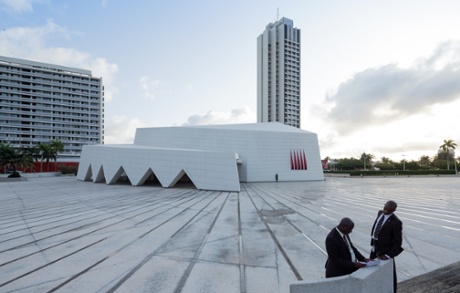
While it may be incomplete, the university is still in use. Sadly, the same cannot be said for an equally maverick project in Ivory Coast’s economic capital of Abidjan. La Pyramide market, designed by Italian architect Rinaldo Olivieri between 1968–73, now stands as a vacant monument to its own grand ambitions. A great concrete pyramid strapped to a pair of lift towers as if ready for takeoff, it was a brave attempt to reinvent the covered market for the African city. Keen not to replicate the mistakes of the hermetic glazed towers that were cropping up across Abidjan, Olivieri aimed to capture the lively free-for-all spirit of the markets he had visited in nearby villages. He designed a large central hall full of activity, above which offices, studios and restaurants would step back in a big hollow ziggurat – all stacked on top of a gargantuan basement, complete with supermarket, nightclub and parking for 1,800 cars.
It was nothing if not optimistic. But with high maintenance costs and a hugely inefficient ratio of rentable space to circulation, it proved a massive failure, left empty since the 1980s economic crash and now gutted and partly squatted. Its fate, like many of the buildings in the exhibition, remains precarious.
And that’s partly what makes this show, and the accompanying book, so compelling. A lot of these buildings won’t be around for much longer. One of Hertz’s favourite projects, a spectacular UFO-shaped hovering nightclub in Nairobi, was torn down last summer. “We urgently need to make people aware of this fascinating heritage,” says Herz. “To put it bluntly, when we think of the futuristic architecture of the 1960s, we think of Oscar Niemeyer first – but a lot of these buildings are so much better. When you see FIDAK, you can forget about Niemeyer.”
guardian.co.uk © Guardian News & Media Limited 2010
Published via the Guardian News Feed plugin for WordPress.
